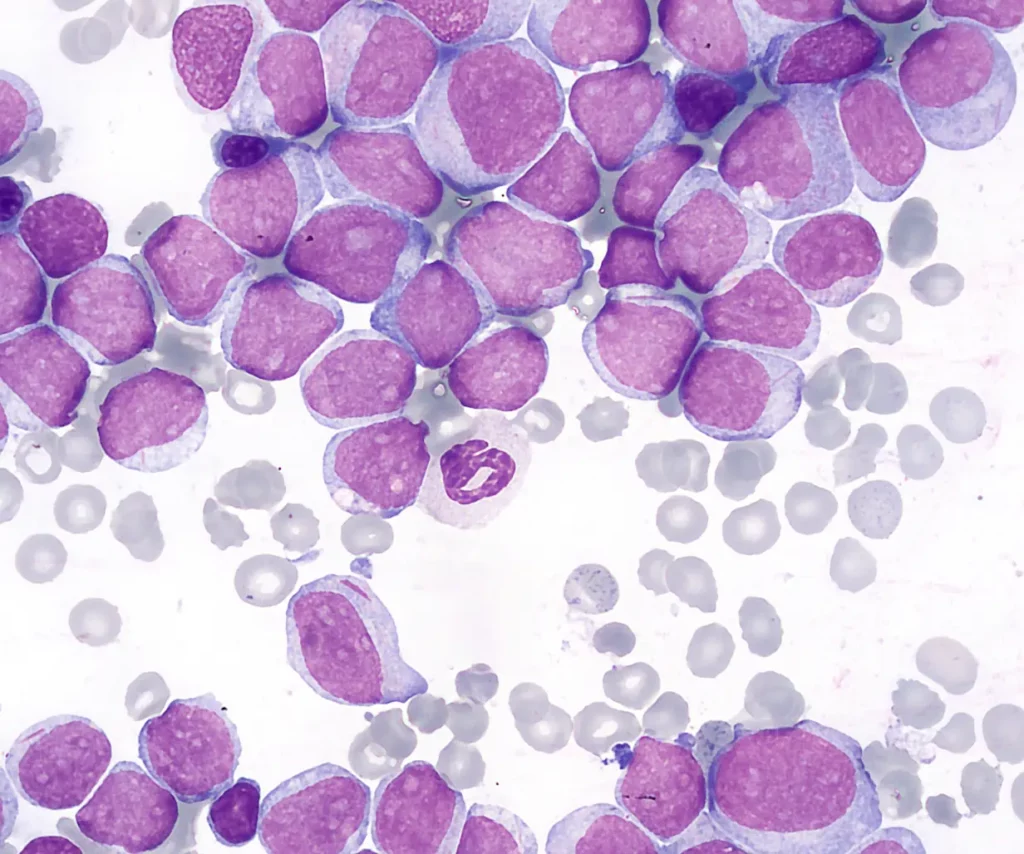Acute Myeloblastic Leukemia (AML) is a type of cancer that affects the myeloid line of blood cells, characterized by the rapid growth of abnormal cells in the bone marrow and blood. This aggressive cancer can be life-threatening if left untreated, impacting the production of normal blood cells and leading to symptoms like fatigue, easy bruising, and increased infection risk.
Table of Contents
Key Points/Summary
- AML is a rapidly progressing cancer that affects the myeloid cells in the bone marrow.
- Symptoms include fatigue, easy bruising, shortness of breath, and an increased risk of infections.
- The condition is more common in adults over 60 but can also affect younger individuals and children.
- Genetic mutations play a significant role in the development of AML.
- Treatment options include chemotherapy, radiation therapy, and stem cell transplantation.
- The prognosis varies depending on factors like age, subtype of AML, and response to treatment.
Prevalence/Incidence
- AML affects about 4 in 100,000 adults annually, with approximately 1,160 children diagnosed each year.
Related: Acute Lymphoblastic Leukemia
Risk Factors
Risk factors for AML include:
- Increasing age
- Exposure to radiation
- Certain chemicals like benzene
- Previous cancer treatment
- Genetic disorders like Down syndrome
Signs and Symptoms
- Early symptoms of AML may mimic common illnesses like the flu, progressing to more severe symptoms such as fever, bone pain, pale skin, and frequent infections.
Prevention Strategies
- AML cannot be prevented as the exact triggers for genetic mutations leading to the disease are not fully understood. However, avoiding known risk factors like smoking and exposure to harmful chemicals may help reduce the risk.
Screening Modalities
- There are no standard screening tests for AML. Diagnosis usually occurs when symptoms prompt further investigation.
Diagnosis of Acute Myelogenous Leukemia
Diagnosis of AML is based on accurate clinical history, physical exam, laboratory and imaging studies
Laboratory diagnosis of AML
Several studies are Laboratory Studies for Diagnosis of AML
Complete Blood Count (CBC)
A CBC evaluates the overall health of the blood by measuring the number of red blood cells, white blood cells, and platelets. In AML, the CBC often shows elevated white blood cell counts primarily due to the presence of leukemia cells, and decreased red blood cells and platelets, indicating anemia and thrombocytopenia.
Peripheral Blood Smear
This test involves examining a drop of blood under a microscope to identify the types and characteristics of blood cells. In AML, the smear typically reveals a high number of immature white blood cells (blasts), which are indicative of the disease.
Bone Marrow Aspiration and Biopsy
Immunophenotyping (Flow Cytometry)
This test identifies specific proteins on the surface of blood cells, helping to classify the type of leukemia. It distinguishes AML from other leukemias, such as acute lymphoblastic leukemia (ALL), and can provide prognostic information based on the presence of certain markers.
Cytogenetic Analysis (Karyotyping)
Cytogenetic tests examine the chromosomes in the cells from blood or bone marrow samples. This analysis can identify chromosomal abnormalities associated with different subtypes of AML, which are crucial for prognosis and treatment planning.
Molecular Testing
Molecular tests look for specific genetic mutations in the leukemia cells. These mutations can influence treatment decisions, as some targeted therapies are designed to attack specific genetic changes found in AML.
Coagulation Studies
These tests assess the blood’s ability to clot. In AML, particularly the acute promyelocytic leukemia (APL) subtype, patients may exhibit disseminated intravascular coagulation (DIC), which can complicate the disease and its management.
Lactate Dehydrogenase (LDH) Level
An elevated LDH level is often found in patients with AML and can indicate high cell turnover or tumor lysis syndrome, a potential complication of the disease.
Blood Cultures
Blood cultures are performed to detect any infections, which are common in AML patients due to compromised immunity. This is particularly important if the patient presents with fever or other signs of infection.These laboratory studies collectively provide a comprehensive approach to diagnosing AML, informing both the classification of the disease and the subsequent treatment strategies.
Diagnosis of AML involves bone marrow aspiration and blood tests to identify abnormal cells and genetic mutations.
Treatment and Management of AML
Treatment options for AML include c
- chemotherapy,
- radiation therapy, and
- stem cell transplantation.
- Allogeneic stem cell transplantation is currently the only curative option.
Prognosis varies, with factors like age, subtype of AML, and response to treatment influencing survival rates.
AML: Conclusion
In conclusion, Acute Myeloblastic Leukemia is a challenging condition that requires prompt diagnosis and appropriate treatment. Understanding the risk factors, symptoms, and available treatment options is crucial for effectively managing this type of leukemia. If you or a loved one are facing AML, seeking medical advice and exploring treatment options tailored to your specific situation is essential for the best possible outcome.
Disclaimer
The information provided on this medical blog is for general informational purposes only and should not be considered as a substitute for professional medical advice. Always consult with a qualified healthcare provider before making any healthcare decisions or taking any actions based on the information provided on this blog. The authors and publishers of this blog are not liable for any errors or omissions in the content or for any actions taken based on the information provided.

